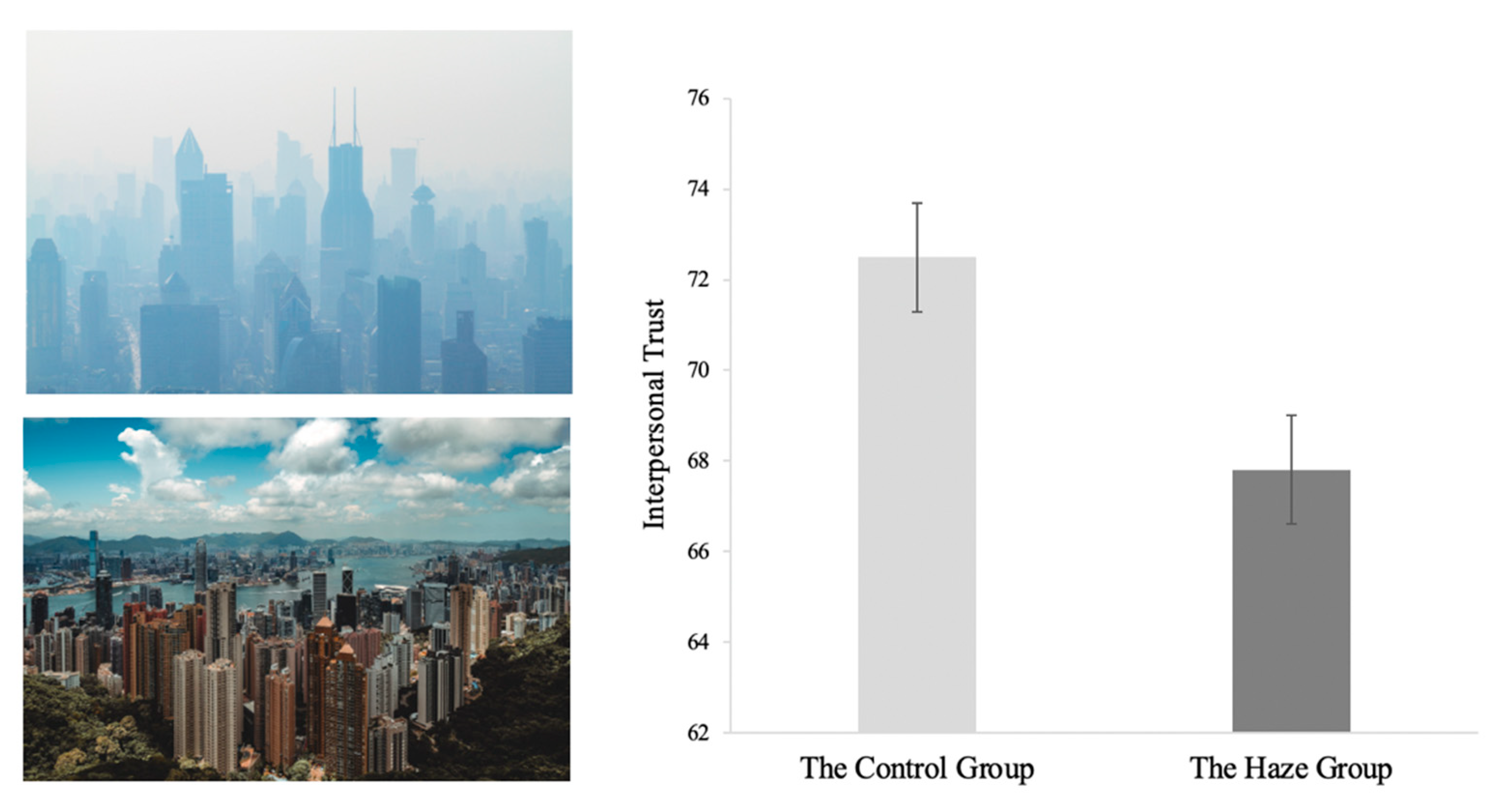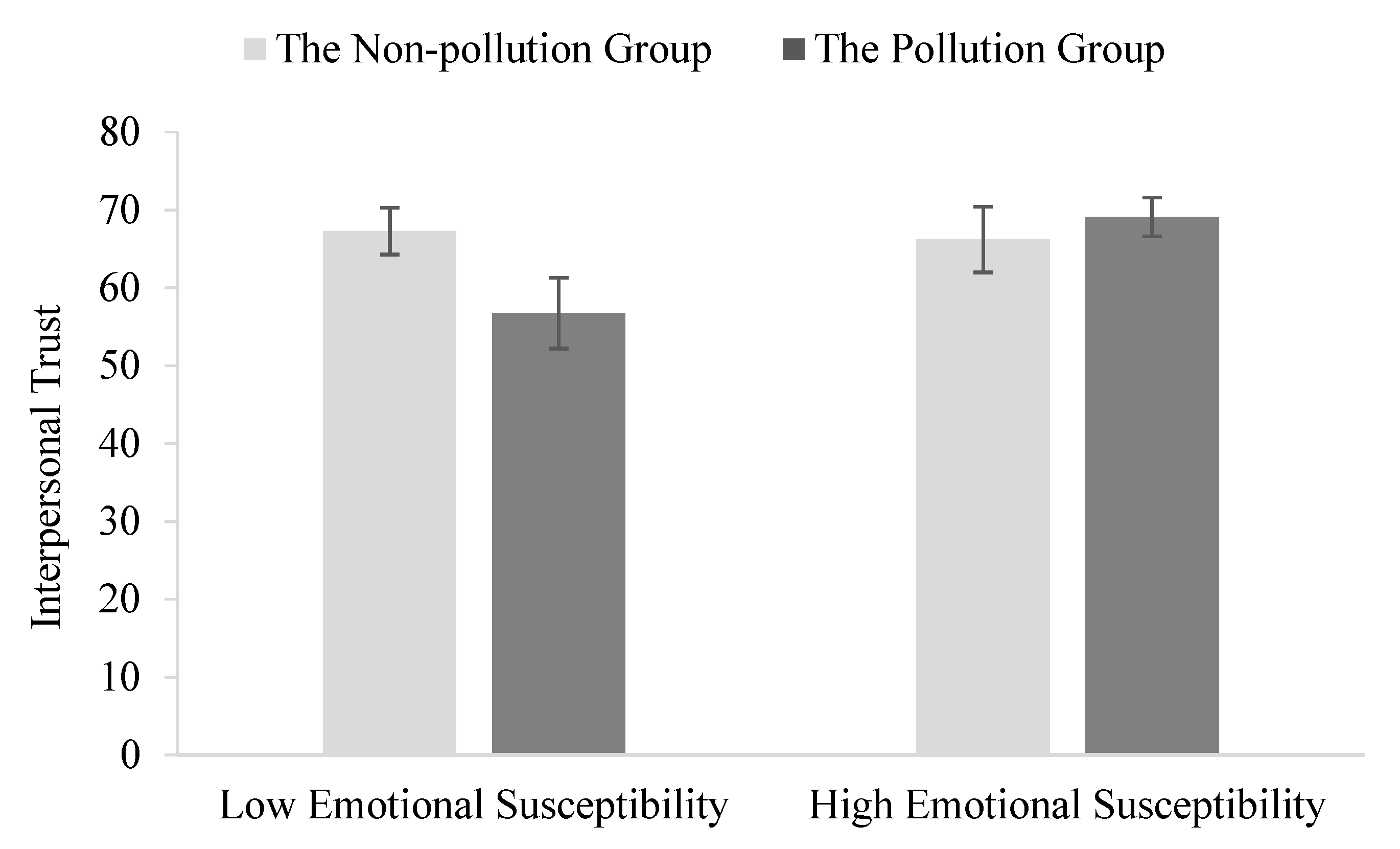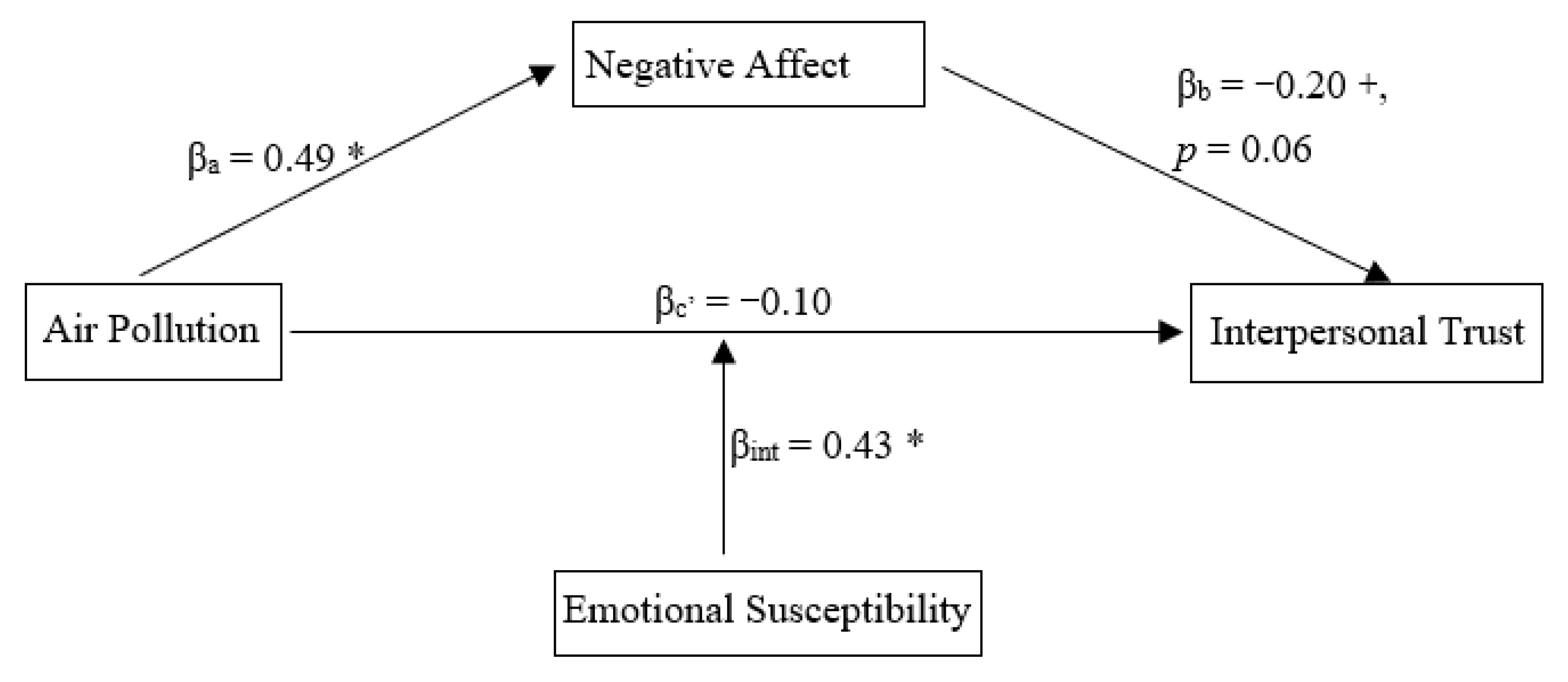Air Pollution Reduces Interpersonal Trust: The Roles of Emotion and Emotional Susceptibility
Abstract
1. Introduction
1.1. Air Pollution and Its Negative Consequences
1.2. Interpersonal Trust and the Contributing Factors
1.3. The Role of Emotion and Emotional Susceptibility
1.4. The Present Research
2. Study 1: Haze and Interpersonal Trust
2.1. Method
2.1.1. Participants
2.1.2. Procedure
2.2. Results and Discussion
3. Study 2: Haze and Emotions Expressed in Social Media
3.1. Method
3.1.1. Data Collection
3.1.2. Data Coding
3.2. Results and Discussion
4. Study 3: The Roles of Emotion and Emotional Susceptibility
4.1. Method
4.1.1. Participants
4.1.2. Procedure
4.2. Results and Discussion
5. General Discussion
5.1. Implications
5.2. Limitations
6. Conclusions
Supplementary Materials
Author Contributions
Funding
Institutional Review Board Statement
Informed Consent Statement
Data Availability Statement
Conflicts of Interest
References
- Liu, J.; Yin, H.; Tang, X.; Zhu, T.; Zhang, Q.; Liu, Z.; Tang, X.L.; Yi, H.H. Transition in air pollution, disease burden and health cost in China: A comparative study of long-term and short-term exposure. Environ. Pollut. 2021, 277, 116770. [Google Scholar] [CrossRef] [PubMed]
- Pope, C.A.; Turner, M.C.; Burnett, R.T.; Jerrett, M.; Brook, R.D. Relationships between fine particulate air pollution, cardiometabolic disorders, and cardiovascular mortality. Circ. Res. 2015, 116, 108–115. [Google Scholar] [CrossRef]
- Braithwaite, I.; Zhang, S.; Kirkbride, J.B.; David, P.J.O.; Hayes, J.F. Air pollution (particulate matter) exposure and associations with depression, anxiety, bipolar, psychosis and suicide risk: A systematic review and meta-analysis. Environ. Health Perspect. 2019, 127, 126002. [Google Scholar] [CrossRef]
- Rowland, T.; Majid, M. Air pollution: An environmental risk factor for psychiatric illness? Bipolar Disord. 2020, 22, 309–310. [Google Scholar] [CrossRef]
- Briere, J.; Downes, A.; Spensley, J. Summer in the city: Urban weather conditions and psychiatric emergency-room visits. J. Abnorm. Soc. Psychol. 1983, 92, 77–80. [Google Scholar] [CrossRef]
- Yang, A.C.; Tsai, S.-J.; Huang, N.E. Decomposing the association of completed suicide with air pollution, weather, and unemployment data at different time scales. J. Affect. Disord. 2011, 129, 275–281. [Google Scholar] [CrossRef]
- Power, M.C.; Kioumourtzoglou, M.-A.; Hart, J.E.; Okereke, O.I.; Laden, F.; Weisskopf, M.G. The relation between past exposure to fine particulate air pollution and prevalent anxiety: Observational cohort study. BMJ 2015, 350, h1111. [Google Scholar] [CrossRef]
- Rotton, J.; Barry, T.; Frey, J.; Soler, E. Air Pollution and interpersonal Attraction. J. Appl. Soc. Psychol. 1978, 8, 57–71. [Google Scholar] [CrossRef]
- Lu, J.G.; Lee, J.J.; Gino, F.; Galinsky, A.D. Polluted morality: Air pollution predicts criminal activity and unethical behavior. Psychol. Sci. 2018, 29, 340–355. [Google Scholar] [CrossRef]
- Kuttanda, V.; Philip, J.N. Weather, mood and helping behavior: A comparative study between two Indian cities (Chennai and Mysore). J. Psychosoc. Res. 2018, 13, 453–467. [Google Scholar] [CrossRef]
- Roberts, S.; Arseneault, L.; Barratt, B.; Beevers, S.; Danese, A.; Odgers, C.L.; Moffitt, T.E.; Reuben, A.; Kelly, F.J.; Fisher, H.L. Exploration of NO2 and PM2.5 air pollution and mental health problems using high-resolution data in London-based children from a UK longitudinal cohort study. Psychiatry Res. 2019, 272, 8–17. [Google Scholar] [CrossRef]
- Rotter, J.B. A new scale for the measurement of interpersonal trust. J. Personal. 1967, 35, 651–665. [Google Scholar] [CrossRef]
- Sønderskov, M.K. Explaining large-N cooperation: Generalized social trust and the social exchange heuristic. Ration. Soc. 2011, 23, 51–74. [Google Scholar] [CrossRef]
- Tatarko, A. Trust, cooperative behavior and economic success: When trust is the capital of the person? HSE Work. Pap. 2014. [Google Scholar] [CrossRef]
- Bitmiş, M.G.; Ergeneli, A. The role of psychological capital and trust in individual performance and job satisfaction relationship: A test of multiple mediation model. Procedia Soc. Behav. Sci. 2013, 99, 173–179. [Google Scholar] [CrossRef]
- Jong, B.; Elfring, T. How does trust affect the performance of ongoing teams? The mediating role of reflexivity, monitoring, and effort. Acad. Manag. J. 2010, 53, 535–549. [Google Scholar] [CrossRef]
- Zheng, B.X. The trust relationship between superior and subordinate in an enterprise organization. Sociol. Res. 1999, 24–39. [Google Scholar] [CrossRef]
- Burke, C.S.; Sims, D.E.; Lazzara, E.H.; Salas, E. Trust in leadership: A multi-level review and integration. Leadersh. Q. 2007, 18, 606–632. [Google Scholar] [CrossRef]
- Lumineau, F.; Guo, S.L.; Lewicki, R.J. Revisiting the foundations of organizational distrust. Soc. Sci. Electron. Publ. 2015, 1, 1–88. [Google Scholar] [CrossRef]
- Boarini, R.; Comola, M.; Smith, C.; Manchin, R.; Keulenaer, F.D. What makes for a better life? The determinants of subjective well-being in OECD countries—Evidence from the Gallup World Poll. OECD Stat. Work. Pap. 2012. [Google Scholar] [CrossRef]
- Mayer, R.C.; Davis, J.H.; Schoorman, F.D. An integrative model of organizational trust. Acad. Manag. Rev. 1995, 20, 709–734. [Google Scholar] [CrossRef]
- Righetti, F.; Finkenauer, C. If you are able to control yourself, I will trust you: The role of perceived self-control in interpersonal trust. J. Personal. Soc. Psychol. 2011, 100, 874–886. [Google Scholar] [CrossRef] [PubMed]
- Stamos, A.; Altsitsiadis, E.; Dewitte, S. Investigating the effect of childhood socioeconomic background on interpersonal trust: Lower childhood socioeconomic status predicts lower levels of trust. Personal. Individ. Differ. 2019, 145, 19–25. [Google Scholar] [CrossRef]
- Knack, S.; Keefer, P. Does social capital have an economic payoff? A cross-country investigation. Q. J. Econ. 1997, 112, 1251–1288. [Google Scholar] [CrossRef]
- Gheorghiu, M.A.; Vignoles, V.L.; Smith, P.B. Beyond the United States and Japan: Testing Yamagishi’s emancipation theory of trust across 31 nations. Soc. Psychol. Quart. 2009, 72, 365–383. [Google Scholar] [CrossRef]
- Xin, Z.Q.; Zhou, Z. A cross-temporal meta-analysis of changes in Chinese college students’ interpersonal trust. Adv. Psychol. Sci. 2012, 20, 344–353. [Google Scholar] [CrossRef]
- Pope, C.A.; Dockery, D.W. Health effects of fine particulate air pollution: Lines that connect. J. Air Waste Manag. Assoc. 2006, 56, 709–742. [Google Scholar] [CrossRef] [PubMed]
- Turner, M.C.; Krewski, D.; Pope III, C.A.; Chen, Y.; Gapstur, S.M.; Thun, M.J. Long-term ambient fine particulate matter air pollution and lung cancer in a large cohort of never-smokers. Am. J. Respir. Crit. Care Med. 2011, 184, 1374–1381. [Google Scholar] [CrossRef] [PubMed]
- Kashyap, R.; Gupta, R.; Mansuri, M.A.; Thasale, R. A review on effect of air pollutants on fetal development and pregnancy outcomes. J. Air Pollut. Health 2019, 4, 193–208. [Google Scholar] [CrossRef]
- Moors, A.; Fischer, M. Demystifying the role of emotion in behaviour: Toward a goal-directed account. Cogn. Emot. 2018, 33, 94–100. [Google Scholar] [CrossRef] [PubMed]
- Baylis, P.; Obradovich, N.; Kryvasheyeu, Y.; Chen, H.; Coviello, L.; Moro, E.; Cebrian, M.; Fowler, J.H. Weather impacts expressed sentiment. PLoS ONE 2018, 13, e0195750. [Google Scholar] [CrossRef] [PubMed]
- Evans, G.W.; Jacobs, S.V. Air pollution and human behavior. J. Soc. Issues 1981, 37, 95–125. [Google Scholar] [CrossRef]
- Engelmann, J.B.; Meyer, F.; Ruff, C.C.; Fehr, E. The neural circuitry of affect-induced distortions of trust. Sci. Adv. 2019, 5, eaau3413. [Google Scholar] [CrossRef]
- Doherty, R.W. The emotional susceptibility scale: A measure of individual differences. J. Nonverbal Behav. 1997, 21, 131–154. [Google Scholar] [CrossRef]
- Mazzuca, S.; Kafetsios, K.; Livi, S.; Presaghi, F. Emotion regulation and satisfaction in long-term marital relationships: The role of emotional susceptibility. J. Soc. Personal. Relat. 2018, 36, 2880–2895. [Google Scholar] [CrossRef]
- Cunningham, M.R. Weather, mood, and helping behavior: Quasi experiments with the sunshine samaritan. J. Personal. Soc. Psychol. 1979, 37, 1947–1956. [Google Scholar] [CrossRef]
- Herrnstadt, E.; Muehlegger, E. Air pollution and criminal activity: Evidence from chicago microdata. NBER Work. Pap. 2015. [Google Scholar] [CrossRef]
- Rotton, J.; Frey, J.; Barry, T.; Milligan, M.; Fitzpatrick, M. The air pollution experience and physical aggression 1. J. Appl. Soc. Psychol. 1979, 9, 397–412. [Google Scholar] [CrossRef]
- Mayer, J.D.; Gaschke, Y.N.; Braverman, D.L.; Evans, T.W. Mood-congruent judgment is a general effect. J. Personal. Soc. Psychol. 1992, 63, 119–132. [Google Scholar] [CrossRef]
- Dong, Y.H.; Chen, H.; Lai, K.S.; Yue, G.A. Weibo social moods measurement and validation. Psychol. Sci. 2015, 38, 1141–1146. [Google Scholar] [CrossRef]
- Walther, J.B. Computer-mediated communication: Impersonal, interpersonal, and hyperpersonal interaction. Commun. Res. 1996, 23, 3–43. [Google Scholar] [CrossRef]
- Kramer, A.D.; Guillory, J.E.; Hancock, J.T. Experimental evidence of massive-scale emotional susceptibility through social networks. Proc. Natl. Acad. Sci. USA 2014, 111, 8788–8790. [Google Scholar] [CrossRef] [PubMed]
- Qiu, L.; Lin, H.; Leung, A.K.; Tov, W. Putting their best foot forward: Emotional disclosure on Facebook. Cyberpsych. Behav. Soc. Netw. 2012, 15, 569–572. [Google Scholar] [CrossRef] [PubMed]
- Watson, D.; Clark, L.A.; Tellegen, A. Development and validation of brief measures of positive and negative affect: The PANAS scales. J. Personal. Soc. Psychol. 1988, 54, 1063–1070. [Google Scholar] [CrossRef]
- Hayes, A. Introduction to mediation, moderation, and conditional process analysis. J. Educ. Meas. 2013, 51, 335–337. [Google Scholar] [CrossRef]
- Twenge, J.M.; Campbell, W.K.; Carter, N.T. Declines in Trust in Others and Confidence in Institutions Among American Adults and Late Adolescents, 1972-2012. Psychol. Sci. 2014, 25, 1914–1923. [Google Scholar] [CrossRef] [PubMed]
- Dunn, J.R.; Schweitzer, M.E. Feeling and believing: The influence of emotion on trust. J. Personal. Soc. Psychol. 2005, 88, 736–748. [Google Scholar] [CrossRef]
- Diener, E.; Seligman, M.E.P. Very happy people. Psychol. Sci. 2002, 13, 81–84. [Google Scholar] [CrossRef]



| City | AQI | Air Pollution Level | The Minimum AQI in the Past 48 h | The Maximum AQI in the Past 48 h |
|---|---|---|---|---|
| Guangzhou | 114 | mild level | 82 | 138 |
| Shanghai | 121 | mild level | 55 | 159 |
| Nanjing | 163 | moderately polluted | 73 | 217 |
| Chongqing | 154 | moderately polluted | 59 | 162 |
| Xi‘an | 293 | heavily polluted | 139 | 354 |
| Beijing | 109 | mild level | 27 | 228 |
| Taiyuan | 193 | moderately polluted | 113 | 294 |
| M | SD | 1 | 2 | 3 | 4 | 5 | |
|---|---|---|---|---|---|---|---|
| 1 Positive emotion | 0.71 | 1.04 | — | ||||
| 2 Negative emotion | 0.25 | 0.68 | −0.07 | — | |||
| 3 Real-time AQI | 160.19 | 70.47 | −0.16 ** | 0.06 | — | ||
| 4 The minimum AQI in the past 48 h | 72.63 | 37.48 | −0.02 | 0.04 | 0.42 ** | — | |
| 5 The maximum AQI in the past 48 h | 204.29 | 81.26 | −0.12 ** | 0.04 | 0.68 ** | 0.50 ** | — |
| M | SD | 1 | 2 | 3 | |
|---|---|---|---|---|---|
| 1 Negative affect | 19.22 | 7.56 | |||
| 2 Positive affect | 28.18 | 6.84 | −0.02 | ||
| 3 Emotional susceptibility | 55.22 | 7.56 | 0.09 | 0.32 ** | |
| 4 Interpersonal trust | 67.81 | 8.54 | −0.22 * | 0.07 | 0.16 |
Publisher’s Note: MDPI stays neutral with regard to jurisdictional claims in published maps and institutional affiliations. |
© 2021 by the authors. Licensee MDPI, Basel, Switzerland. This article is an open access article distributed under the terms and conditions of the Creative Commons Attribution (CC BY) license (https://creativecommons.org/licenses/by/4.0/).
Share and Cite
Hou, Y.; Gao, M.; Huang, L.; Wang, Q. Air Pollution Reduces Interpersonal Trust: The Roles of Emotion and Emotional Susceptibility. Int. J. Environ. Res. Public Health 2021, 18, 5631. https://doi.org/10.3390/ijerph18115631
Hou Y, Gao M, Huang L, Wang Q. Air Pollution Reduces Interpersonal Trust: The Roles of Emotion and Emotional Susceptibility. International Journal of Environmental Research and Public Health. 2021; 18(11):5631. https://doi.org/10.3390/ijerph18115631
Chicago/Turabian StyleHou, Yubo, Meiqi Gao, Lianqiong Huang, and Qi Wang. 2021. "Air Pollution Reduces Interpersonal Trust: The Roles of Emotion and Emotional Susceptibility" International Journal of Environmental Research and Public Health 18, no. 11: 5631. https://doi.org/10.3390/ijerph18115631
APA StyleHou, Y., Gao, M., Huang, L., & Wang, Q. (2021). Air Pollution Reduces Interpersonal Trust: The Roles of Emotion and Emotional Susceptibility. International Journal of Environmental Research and Public Health, 18(11), 5631. https://doi.org/10.3390/ijerph18115631





